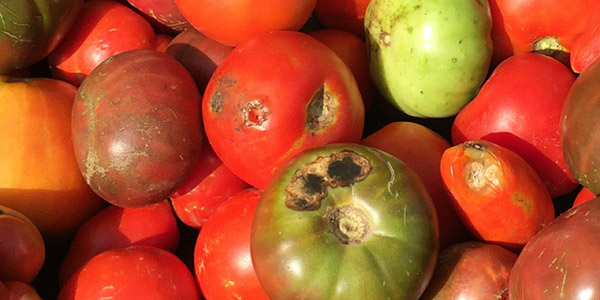Have you noticed a lot of “ugly food” stories in your newsfeeds lately? The movement that took root in food waste activist circles is now front and center as evidenced by Wal-Mart’s foray into selling ugly fruits and vegetables.
Some very creative minds are joining the effort. As reported in Modern Farmer, CUESA (Center for Urban Education About Sustainable Agriculture) just launched a humorous, racy ad campaign designed to get Bay Area consumers to local farmers’ markets. Loaded with innuendo (think Tinder and Craigslist “casual encounters”), the ads feature “ugly” fruits and veggies that look a lot like body parts.
Yahoo! Beauty and Style Writer Kristine Soloman calls out superficial shoppers in her post entitled “’Food Has a Body Image Issue’: Why Americans Prefer Pretty Produce.” Referencing a Salon article on the same topic, she states that we are projecting our image insecurities onto the fruits and vegetables we shop for—something Chef Evan Hanczor discussed in a Facebook Live broadcast from the Democratic National Convention.
Hanczor is blown away (along with the rest of us) by the fact that we waste 40 percent of the food we produce. He explains that consumers’ reluctance to buy “ugly” foods creates waste along the supply chain. Retailers send food that doesn’t meet shoppers’ appearance standards back to farmers. In turn, farmers do not bother picking food that will likely be returned. All the while, landfills are filling-up with ugly food that is releasing staggering amounts of methane gas into the environment. (As a greenhouse gas, methane is 21 times more potent than CO2.)
Far too many Americans still value aesthetic perfection over all else. A pyramid of polished, same-sized, gas-ripened, ultra-red, flavor-free tomatoes holds infinitely more appeal than scarred-up, misshapen, flavorful heirlooms at a farmer’s stand.
In many ways, we have the marriage of industrialized farming and retail merchandising to thank for our shallow expectations. Over the past 20 years, we’ve come to associate a flawless appearance with quality and wholesomeness. But organizations like Environmental Working Group have put a lot of effort into exposing the façade. (Check out EWG’s “Dirty Dozen” list.) Buying for beauty doesn’t just deny consumers flavor, it can have serious health implications.
Setting aside the psychological processing of why we shop the way we do (ego or otherwise), it is important to note that food waste is not just an environmental concern. Feeding America reports that 48.1 million Americans live in food insecure households. The Ugly Food Movement is rapidly chipping away at that number. Throughout the country, networks of restaurants, distributors, grocery stores, farmers, shelters and other organizations and businesses are banding together to relive hunger while curbing food waste. And smart phone applications like the one developed by Food Cowboy are aiding the effort.
In just a few years, this movement has already had a far-reaching impact on personal, community and global health. Now that it has really hit the mainstream, the possibilities seem limitless. To get a better sense of the big picture, we recommend taking the time to read National Geographic’s “deep-dive” article: How ‘Ugly’ Fruits and Vegetables Can Help Solve World Hunger.

